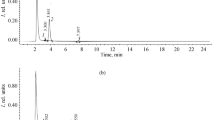Abstract
An improved TLC method ofFusaria metabolites detection and quantitation has been elaborated. A total 92 isolates of Discolor sectionFusaria from cereals and potato have been examined from the point of view of cultures morphology and ability to produce characteristic mycotoxins. Low nutrient media (CLA, SNA) were found as suitable for production of uniform and typical macroconidia in studied cultures. All 26 isolates ofF. sambucinum Fuckel (=F.sulphureum, Schlecht) formed diacetoxyscirpenol in amount 20-1000 mg/kg and all 17.F. crookwellense Burgess N. & T. produced zearalenone (16-602 mg/kg).F. graminearum Schwabe produced: zearalenone 14/14 isolates, deoxynivalenol 11/14 isolates, both up to 77 mg/kg. Out of 26F. culmorum cultures originating from Poland 22 produced zearalenone up to 675 mg/kg, 17/26 3 acetyldeoxynivalenol up to 280 mg/kg and 16/26 deoxynivalenol up to 220 mg/kg. The difference in metabolism agrees with the difference in morphology of those species.
Similar content being viewed by others
References
Cheĺkowski J., Visconti A., Solfrizzo M., Bottalico A. (1984) Formation of mycotoxins by Fusarium species from cereals in Poland. Phytopath medit 23: 43–46.
Burgess L.W., Nelson P.E. and Toussoun T.A. (1982) Characterization, geographic distribution and ecology of Fusarium crookwellense. Sp.nov. Trans Br.mycol Soc. 79: 497–505.
Marasas W.F.O., Nelson P.E., Toussoun (1984) Toxigenic Fusarium species, identity and mycotoxicology. The Pennsylvania State University Press, University Park and London.
Thrane U. (1986) Detection of toxigenic Fusarium isolates by thin layer chromatography. Letters in Applied Microbiol. 3: 93–96.
Nirenberg H. (1981) A simplified method fe identifying Fusarium spp occuring on wheat. Can. J. Bot. 59: 1599–1609.
Nelson P.E., Toussoun T.A., Marasas W.F.O. (1983) Fusarium species. An illusstrated manual for identification. The Pennsylvania State University Press, University Park and London.
Bottalico A., Lerario P., Visconti A. (1983) Production of mycotoxins (zearalenone, trichothecenes and moniliformin) by Fusarium species in Italy. Microbiol. Alim. Butr. 1: 133–142.
Visconti A., Cheĺkowski J. and Bottalico A. (1986) Deoxynivalenol and 3 acetyldeoxynivalenol — mycotoxins associated with wheat head fusariosis in Poland. Mycotoxin Research 2: 59–64.
Desjardins A. and Beremand M. (1987) A genetic system for trichothecenes toxin production in Gibberella pulicaris (Fusarium sambucinum). Phytopathology 77: 678–683.
Author information
Authors and Affiliations
Rights and permissions
About this article
Cite this article
Perkowski, J., Kwaśna, H., Latus, D. et al. Mycotoxins produced by Discolor section Fusarium species. Mycotox Res 3 (Suppl 1), 41–45 (1987). https://doi.org/10.1007/BF03192025
Issue Date:
DOI: https://doi.org/10.1007/BF03192025




